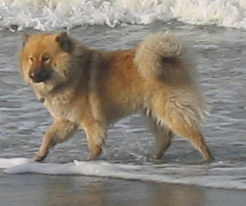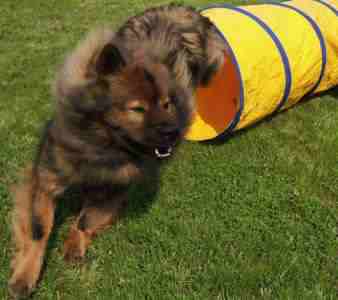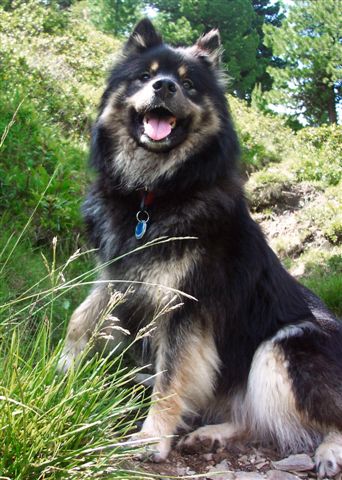EURASIAN (Eurasier)

FCI-Standard N° 291 / 16. 06. 1999 / GB
TRANSLATION : Mrs. C. Seidler.
ORIGIN : Germany.
DATE OF PUBLICATION OF THE ORIGINAL VALID STANDARD : 06.01.1994.
UTILIZATION : Companion dog.
CLASSIFICATION F.C.I. : Group 5 Spitz and primitive type.
Section 5 Asiatic Spitz and related breeds.
Without working trial.
BRIEF HISTORICAL SUMMARY : In 1960 a breed was evolved by crossing a Chow Chow and a Wolfspitz. This was first called « Wolf-Chow » and then, after crossing with a Samoyed, was re-named « Eurasier » (Eurasian) and recognized by the F.C.I.
GENERAL APPEARANCE : Balanced, well constructed medium sized dog of Spitz type with prick ears and coat in varied colours. Length of coat should be such as still to reveal the body proportions. With medium bone.
IMPORTANT PROPORTIONS : Length of back slightly longer than height at withers. The ratio of length of muzzle and length of cranial region is almost equal.
BEHAVIOUR / TEMPERAMENT : Self-assured, calm, even tempered with high resistance against any provocation. Watchful and alert without being noisy. Very strongly developed link to his family. Reserved towards strangers without being aggressive. No hunting instinct. For the full development of these qualities, the Eurasian needs constant close domestic contact with his family and understanding, yet consistent training.
SUGGESTED BREEDINGS by MENANDPETS.COM:
No breeding to signal
if you want to know like signaling yours, contacts: marketing@inseparabile.it
HEAD : Balanced, not too broad skull. Shape of head seen from above and in profile, wedge-shaped. Bridge of nose and skull run parallel.
CRANIAL REGION : Flat forehead with distinct frontal furrow. Well defined occiput.
Stop : Barely defined.
FACIAL REGION :
Nose : Medium size, nose leather with black pigmentation.
Muzzle : Neither too coarse nor too pointed. Tapering towards the nose. Straight bridge of nose and straight mandibles.
Lips : Edges of lips tight with black pigmentation.
Jaws/Teeth : Strong; broad dental in lower jaw. Strong complete set of teeth (42 teeth conforming to usual tooth formation). Bite either scissor or pincer. Upper incisors either fit closely over lower incisors or they meet. Premolars and molars set in one line without gaps. All teeth must be in vertical position to jaw.
Cheeks : Hardly pronounced.
Eyes : Dark, medium size, not too deep set nor protruding. Lid aperture slightly slanting. Eye-rims with black pigmentation and tight fitting.
Ears : Set apart by about the width of the base of an ear. Medium size and triangular. Prick ears with tips slightly rounded. Tips of ears and centre of stop should form a nearly equilateral triangle.
NECK : Of medium length, in balance with general appearance. Well muscled. Skin on throat tight fitting. Flowing transition to body.
BODY :
General appearance : Strong, not too short in back.
Withers : Pronounced.
Back : Firm and straight. Very well muscled.
Loin : Of good length and width, very well muscled.
Croup : Straight, broad and strong.
Chest : Reaching to the elbows with oval shaped ribcage. Forechest well developed without being pronounced. Sternum long, reaching far back.
Lower line : Slight tuck up.
TAIL : Straight set on, round and firm, of good thickness, tapering towards the tip. Bushy hair. Carried lying forward over back or bent slightly sideways or rolled up. When hanging down, reaching the hocks.
LIMBS
FOREQUARTERS :
General appearance : Seen from front, straight and parallel in position. Seen from side, moderately angulated. Upper arm and forearm of almost equal length.
Shoulders : Well muscled. Lying slightly slanted.
Upper arm : Medium length, well muscled.
Elbows : Close to chest.
Forearm : Medium length, well muscled.
Pastern joint : Strong.
Pastern : Medium length, quite straight seen from front, seen from side, inclined slightly forward.
Forefeet : Oval; tigh, moderately arched toes. Strong nails with dark pigmentation. Firm, well cushioned, black pigmented pads. Thick hair between pads.
HINDQUARTERS :
General appearance : Seen from GO BACK TO LIST, set straight and parallel. Seen from side, with moderate angulation. Upper and lower thigh of almost equal length.
Pelvis : Slightly slanting.
Upper thigh : Medium length with strong muscle.
Stifle : Solid, angle not too open.
Lower thigh : Medium length, well muscled.
Hock joint : Not set too low, stable, neither turning in nor out.
Hock (Metatarsus) : Good length and breadth, vertical when seen from side.
Hind feet : Oval; tight, moderately arched toes. Strong nails with dark pigmentation. Firm, well cushioned pads. Thick hair between pads.
GAIT : Ground covering with plenty of drive and good forward stride.
SKIN : Tight, pigmented.
COAT
HAIR : All over the body a thick undercoat and a medium long, loosely lying, guard hair. Short coat on muzzle, face, ears and front of legs. Tail, back of front legs (feathers) and hind legs (breeches) covered with long hair. Coat on neck only slightly longer than on body, not forming a mane.
COLOUR : All colours and colour combinations are permitted with the exception of pure white, white patches or liver colour.
SIZE AND WEIGHT :
Height at withers : Dogs : 52-60 cm,
Bitches : 48-56 cm.
Weight : Dogs : 23-32 kg,
Bitches : 18-26 kg.
The balance of the proportions is most important but the ideals to aim for are medium height and weight.
Height at withers : Dogs : 56 cm,
Bitches : 52 cm.
Weight : Dogs : 26 kg,
Bitches : 22 kg.
FAULTS : Any departure from the foregoing points should be considered a fault and the seriousness with which the fault should be regarded should be in exact proportion to its degree.
ELIMINATING FAULTS :
- Aggresive or overly shy.
- Nervousness, shyness, excessive suspiciousness.
- Lack of correct gender characteristics.
- Absence of a single or several incisors or canines; absence of a single or several premolars 3 or 4, or single or several molars 1 or 2. Anomalies in bite.
- Ectropion, entropion; eyes too deep set or too small.
- Distichiasis (eyelashes arranged in two raws).
- Semi-pricked or pendulous ears.
- Kinky tail.
- Strong lack of pigment.
Any dog clearly showing physical or behavioural abnormalities shall be disqualified.
N.B. : Male animals should have two apparently normal testicles fully descended into the scrotum.
Automatic translate from inseparabile.comThe history
The origins forgiveness in the night of the times. We find ourselves in the Russian Siberia, between the rivers Ob and Jenisej, near the trib of the Tokana, breeders of reindeers.
We will find again them to Altemberg, in house of Konrad Lorenz, the great etologo prize Nobel for the Medicine in 1973. Exactly 27 February 1973 the race obtains the official acknowledgment.
The ancestors dell ' Eurasier called "Laika di Nenets", and were the result of spontaneous crossings between the Chow-Chow of Siberian Mongolia and the Spitz (influence to you from lupoide blood). The beauty of the aspect, the morboso attachment quais to the own human family, the fierce character, the sturdy physicist, the immense dolcezza, has literally made to innamorare the Prof. Lorenz, that it wanted at all costs to recover this typical ancient race of the Euroasiatico Continent, from which drift the name puts into effect them of Eurasier.
With to Konrad Lorenz and the Mrs. margarethe (its moglie), the merit of this hard job of selection goes in egual measure to the great cinofilo German Julius Wipfel that to Weinheim beginnings the first selections, working for the fissit of the characters is genetics that behavioural. Wipfel taken advantage of the sponsorship and the collaboration of the Universit di Gottinga (for the genetics) and of the Max Plenck Insitute di Heidelberg (for the comportamentalle).
Still today such continuous job, with the same one seriet, rigorosit and scrupolosit to work of the active Eurasier Klub:tre in Germany and one in Austria. They supervise on the genetic lines, control that the dogs very are held and raise to you, regulate the connections. Every year of job and dedication they cannot and they do not have to go makes useless to you.
THE CHARACTER
E' known like "one dog man", "the dog of a single man".
Allegro, extremely affectionate, loves the just similar human devout of if same and arranged to defend it to cost of the own life. Living with eurasier a experience only and irripetibile, above all difficult to explain. its feelings are deepest, demonstrate a morboso attachment to the just similar human and to its family, of the which aware of being integrating part and to whose life participates actively from protagonist.
Pu and it does not have alone to never be, of it would suffer too much, to discapito of the character. Living cos intensely its relationship with the human, finice being in order to assume of its same behaviors: it loves us ch elui it loves, it shares friends and enemies, it is amused of the same things, it loves to make us that it makes.

E' a dominant and therefore a born head: it dislikes who is not submitted. Its education demands firmness and dolcezza together. Character extremely firm, psychologically a lot balanced and irremovibile in its decisions: he never does not change idea n on the things n on the persons. Not sure a dog for all, for this the Klub operates a ' most careful selection on the aspirants "owners", in order to verify that the persons who would want it are effectively in a position to living with he and of offrirgli all us of which has need.
General aspect

Even if sure manifest one tipologia spitz that pu not rinnegare, a particularly fierce, calm dog, with one threshold of elevated reaction, very balanced. Alert and careful without being mental patient, d test of a great attachment in the comparisons of the adoption family.
In detail
The harmonious skull, not too much wide; approval gives over or gives under, to wedge shape. The longitudinal aces of the skull and the nasal cane are parallels. The length of the body leggermente advanced all.altezza to the garrese. The length of the nearly equal skull to that one of the snout. This last one not of
too much heavy too much appuntito some. The teeth are sturdy and healthy. The garrese very delineated and the solid and rectilinear back. The straight, wide and solid rump. The chest comes down until all.altezza of the elbows.
Characteristics
Ransom: the Height comprised between 52 and i 50 cm in the male and between 48 and i 56 cm in the female.
Tail: straight, round and solid to the root, of good thickness, it is lost weight towards the estremit
Colors: from the red one to the sand or the yellow pale, gray-black and black with clear devout areas delimited.
Defects to avoid
. . Too much driven in Sottopelo
. . Orecchie seed-erected, too much discarded or too much adherent
. . Infossati or too much too much small eyes
. . Aggressive character pavido or
. . Square aspect
. . Too much rigid posterior limbs
. . Tigrato cape or with colors stirs to you
FEEDING
FEEDING Of the CUCCIOLO To 2 MONTHS
4 composed pasti/die cos:
- breakfast: 2 lactose-free latte ciotole
- lunch: milled meat of manzo, ribbons of cereals or ribbons of rice in one ciotola of brodo, with a grattugiata abundant of Po grain
- merenda: annealed or 1 vasetto of yogurth Inter with honey or 2 formaggini, 1 ciotola of latte lactose-free
- supper: like the lunch
Integrators: HALIBORANGE and BETOTAL all giorni;OSSIPET the three times to week
To 18 MONTHS
- colazione:1 ciotola of latte lactose-free and biscotti
- pranzo:200g. scottata meat of manzo in frying pan, 150g. of rice bubbled flavored with oil (once of olives and once of maize seeds) and Po
- merenda: 1 ciotola of latte lactose-free and biscotti
- supper: like the lunch
To it appeal to, during the day: croccantini of lamb and rice TECHNICAL LAMB&RICE and cheese (it preprefers that one of goat and sheep)
IN THE ADULT ETA'
- breakfast: 1-2 latte ciotole of lactose-free
- pranzo:250g. scottata meat of manzo in frying pan, 200g. rice bubbled flavored with maize seed, olive oil (once once) and Po
- supper: like the lunch
Fuoripasto: croccantini of lamb and rice TECHNICAL LAMB&RICE, cheese (it preprefers that one of sheep and goat).
For the realizzazzione of this card we thank
Dony Carugati
http://www.douglasvdcondor.altervista.org/